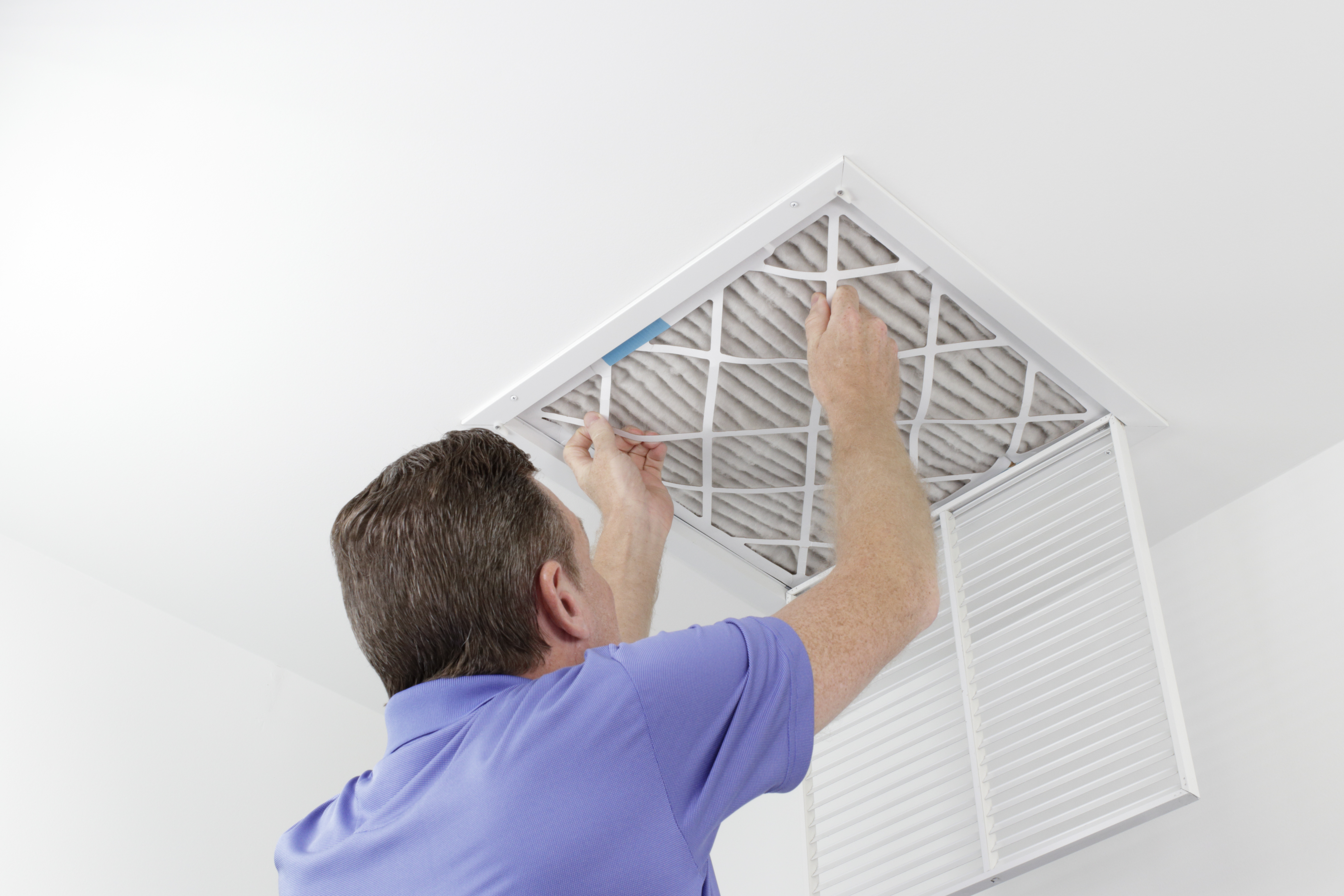HVAC Troubleshooting Guide

Your HVAC system is important for keeping you and your family comfortable in your home. If you’re suddenly dealing with a faulty AC unit before an impending heatwave or a failing heater during a cold snap, you can take steps to diagnose the issue yourself. Read the tips in our HVAC troubleshooting guide to earn what kind of issues demand the expertise of a professional.
Diagnosing HVAC Problems
As a homeowner, it’s important to understand the basic components in your heating, ventilation, and AC system. An HVAC system includes a furnace (or boiler) for heating, an air conditioning unit for cooling, ductwork for dispersing cooled or heated air, and a fan to circulate air. The vents and ventilation system have filters to remove debris, dust, and other air contaminants before the air is circulated through the home. The thermostat controls when each component is on or off.
In addition to troubleshooting common issues, there are some more serious HVAC warning signs you should be aware of. ENERGY STAR gives an overview of key issues that could determine whether you need to replace your HVAC system and research HVAC replacement costs.
Here a few questions that you can ask to give you an idea of how likely it is that you’ll need to replace your HVAC system:
-
Is your furnace or boiler more than 15 years old? If so, it’s likely reached or is nearing the end of its lifespan. Is your AC unit more than 10 years old? It may be time to upgrade your AC.
-
Is your system loud, producing smells, or running too often? These are all signals your HVAC is struggling to keep up with your home’s energy demands.
-
Do you have consistently high energy bills? Inefficient HVAC systems run more frequently since they’re not efficiently cooling, heating, or circulating the air in your home. High energy bills are often the result.

Tips for Troubleshooting HVAC Systems
If you’re not sure how serious your HVAC problem is, consider contacting a contractor to help. Search for HVAC contractors available in your area. It’s important not to tackle complex repairs without experience – especially where wiring and circuitry are concerned.
Troubleshooting Your AC Unit
Cold spots, hot spots, or inadequate airflow? Here are some easy steps you can take to figure out the problem:
Tip #1: Check the outside unit
Look for debris, such as leaves or branches around your outside AC unit, which can get sucked into the unit and cause serious efficiency issues. Signs your outdoor unit needs inspecting, include warm air coming from your air vents, higher-than-average energy bills, and frequent need for repairs. .
If there’s a thick layer of dirt covering your unit’s condenser, you should contact a professional for a deeper clean.
Pro Tip: Keep your unit free of debris in a minimum 3-foot radius to ensure adequate airflow.
Tip #2: Inspect your vents
Are your vents blocked by furniture or plants? If so, those blockages can cause irregular airflow. Ensure your AC vents have at least two feet of free space around them.
Tip #3: Check for dirty filters
If you notice irregular cooling in your home, it might be the result of a dirty or clogged filter. Check your filter. It may be time for a replacement.
Signs of a dirty filter include low airflow, ice on refrigerant lines, water leaks, and cold spots.
Pro Tip: it’s crucial to change your filters regularly as part of your air conditioner’s regular maintenance. 1-inch filters should be switched out every month, 2-inch filters should be switched out every two months and 4 to 5-inch filters should be changed every 6 to 12 months. Consider adding a reminder to your phone to ensure you change your filters regularly.
Tip #4: Address the circuit breakers
When appliances are being installed, power switches or breakers can get turned off. Locate your circuit breaker (usually in your garage, basement, or storage room) and ensure that the issue isn’t as simple as a circuit breaker turned off.
Tip #5: Look for dead batteries or change the thermostat setting
If your thermostat isn’t working properly, your HVAC issues could be as simple as replacing the batteries or setting your thermostat to “cool” instead of “heat”. While this is an easy repair, t’s often easy to forget, especially at the beginning of a new season.
Tip #6: Thaw out summer frost
Sometimes overuse can cause your pipes to freeze over. You can thaw your system in about two hours, or if the issue is persistent, contact a professional for a diagnostic evaluation.
Tip #7: Search for wire breakages
When clearing weeds or landscaping, wires critical to the proper functioning of your air conditioning unit can get clipped. To avoid injury from live wires, If you see out-of-place wires, contact an HVAC pro for repair.
Troubleshooting Your Furnace or Boiler
Feeling chilly while your furnace is on? Follow the tips below.
Tip #8: Switch out the air filter
If your heating unit isn’t pushing out hot air, the filter may need replacing. In fact, many central heat and air conditioning systems share the same filter. So, if your air conditioning isn’t running inefficiently, your furnace could be affected as well.
Tip #9: Check the furnace flame
A healthy furnace flame is blue with a yellow tip. The blue flame signals that your furnace is burning fuel efficiently. Red, yellow, purple or green flames signify a larger issue, requiring inspection by a professional.
Tip #10: Look for pilot light or gas valve issues
If your furnace flame is out, you may need to relight it. However, proceed with caution. Read the owner’s manual for proper directions and turn off the gas for 10 to 15 minutes before trying to relight the pilot. If you still smell gas —you could have a leak and should immediately evacuate your home and call your gas company and the fire department once you’re in a safe location.
Tip #11: Ensure the front panel is secured
A furnace won’t work if the front panel is not pressed in all the way. A quick inspection can determine if this your front panel needs additional securing.
Tip #12: Don’t close your vents
Some homeowners mistakenly close off vents in unused rooms. Unfortunately, this can end up causing airflow problems. Keep all vents open and unobstructed from rugs, furniture, and plants.
Tip #13: Set your thermostat to heat
It’s worth repeating that just like your AC unit won’t blow out cold air if your thermostat is set to “heat” mode, the furnace isn’t going to push heated air out if the thermostat is set to “cool”. Check this at the beginning of a new season to ensure your settings are correct.
Tip #14: Check the limit switch
A faulty limit switch can cause your blower to run continuously, shortening its lifespan. If your switch is faulty or worn out, contact a professional for a replacement.
Tip #15: Identify your furnace noises
Furnaces make a variety of sounds, some of which are not caused for concern. For example, popping noises typically indicate ductwork expansion and contraction during the heating and cooling phases. Other noises may require additional repair. Rattling noises can indicate loose panels that need to be tightened, squealing noises can be a belt issue that requires a belt replacement or repair, and grinding sounds indicate problems with your furnace’s motor bearings. If you hear grinding, it’s time to call an HVAC professional.
Conclusion: Know When to Call in the Pros
If your initial investigation has revealed bigger problems than you expected, you may want to call in a professional contractor or HVAC technician.
If you think you need a full HVAC overhaul PACE financing might be the right solution for you. With Ygrene’s PACE financing, you can afford a more comfortable and energy-efficient home. See if your home qualifies with just a few clicks.




